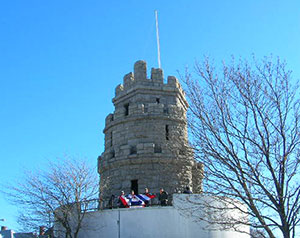By Josie Grove

The city’s most familiar historical landmark is undergoing some much needed shoring up and refurbishing, thanks to the expert work being provided by MJS Construction Inc.
The granite tower looming over Union Square is just over one hundred years old, but its symbolic significance is much older. Prospect Hill was strategically important during the American Revolution, and is the site of first raising of the thirteen-striped Great Union Flag, unfurled on January 1, 1776. In honor of this occasion, the mayor of Somerville hikes to the top of the tower every year on January 1 to raise a flag.
Since the tower’s construction in 1903, the top platform has grown weathered and became unsafe, imperiling the annual flag raising. But tradition will continue on January 1, 2016, once the first phase of the tower’s restoration is complete.
To make the top platform stable again, Mike Selig, President of MJS Construction Inc of Wakefield, MA, says he had to essentially start from scratch. “That was all deteriorated and unstable. We had to demolish the top floor 100%, put in new I-beams, new rebar, and re-pour the concrete.”
The repairs extend well below the top platform. “We’re cutting and pointing the masonry joints, setting any loose stones with epoxy and rebar, and stabilizing everything,” said Selig. Cutting and pointing is a process of grinding down old mortar and replacing it with new mortar. Mortar becomes porous as it ages, allowing water to enter the joints between stones and exposing the masonry to possible damage.
“We are restoring the exterior granite to its original look.” Selig has been repairing cracks in the granite with epoxy, and reinforcing loose stones. He believes the look of the tower is just as important to Somervillians as the flag-raising function. “It brings in a lot of people, we noticed throughout the project. Once, we had to take down all the staging so a couple getting married could have their photos taken.”
The aged aesthetic of the building presents an interesting challenge for masons. “With historic buildings, you’re bringing the existing conditions to make it look like when it was built,” says Selig. He uses a combination of historical research, consultations with preservationists, and his own knowledge. “We’ve done so much [preservation], we know the look.”
Since the tower’s appearance has not changed much over the years, restoration is more a matter of repair than altering the look of the tower. “Even though it’s cracked and broken, you know what you’re bringing it back to.”
Selig can refer to the original mortar, visible just below the surface, to see what he aims to replicate. “The mortar was cracked and it was falling out, but there were areas where you could see what the condition was.” Selig and his team made several different samples of the mortar to see how they could best match the existing color and texture. Once they settled on a match, “We would use that every single time. Every day, we would use that exact same mix, with the exact same speck, so that it looks uniform. We use a mortar with a special speck in it and a little color to keep its original look, that aged look.” Selig explains that mortar that has been exposed to the elements for a century looks rockier than smooth new mortar, and he wanted to maintain the patina of the mortar on the tower. “When you get into historic, the rocks [in the mortar] start to show, so we brought out and raised the rocks to make it look historic.”
The repairs are meant to blend seamlessly with the hundred-year-old stones. “It’s like we never were there.” The renovations are to be completed by next week, just in time for the mayor to raise the flag once again.















Reader Comments